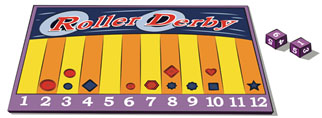Roller Derby

How to Play
The game involves a paper board with the numbers 1-12 listed across the bottom. Each player places 12 markers on the numbers 1-12 on a game board. They take turns rolling two dice, adding the amounts on the dice, and removing a marker from their board with that sum. The first person to remove all their markers wins.
Goal
As the game is played several times, students look for patterns to make better choices for placing their markers. In the process, they are developing basic knowledge of probability and how knowledge of probability helps in making better decisions. Analyzing the game can also reinforce their understanding of fractions, ratios, and proportional reasoning.
Materials
-
Roller Derby Game Board for each player or team
You can print a Labsheet or make one by drawing 12 columns & labeling the columns with the numbers 1–12. - 2 Dice. If you can’t find dice, you can use a dice simulator online such as: Virtual Dice Roller or Dice Roller
- 12 Game Markers for each player or team. You can use coins, small pieces of paper, buttons, or pebbles.
Rules
Any number of players can play at a time.
- Each player or team places 12 markers into the columns of the game board any way you choose.
- Roll a pair of dice. It does not matter who rolls the dice, but players should take turns.
- Add the numbers on the dice. Remove a marker from your game board that is in the same column as the sum. If that column is empty, you do not remove any markers.
- The first team or person to remove all of their markers wins.
Creative Ideas to Enhance the Game
Keep track of all of the sums that you roll as you play the game multiple times. The results may give you some experimental hints where to place the markers in future games.
Also, you can have children look at how you can get each sum with the roll of the dice. This will give you some theoretical hints where to place the markers in future games. For example, you can get a sum of 4 in three different ways by rolling: 1 & 3 or 2 & 2 or 3 & 1.
Mathematics Involved
Probability